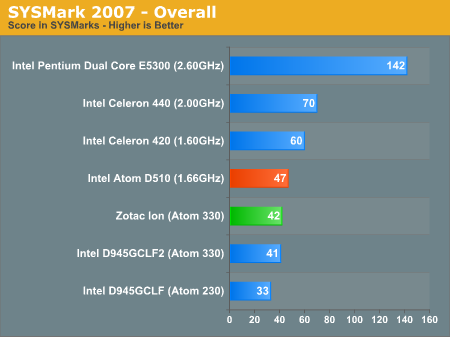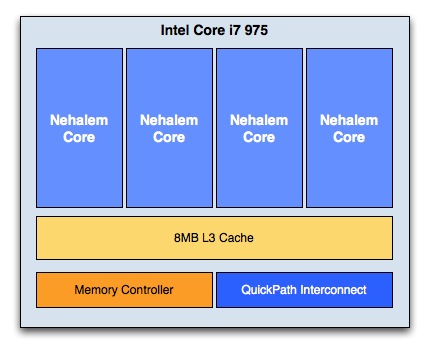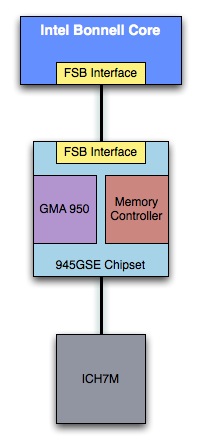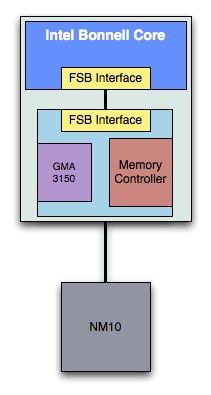Why Pine Trail Isn't Much Faster Than the First Atom
by Anand Lal Shimpi on January 27, 2010 12:48 PM EST- Posted in
- CPUs
In 2008 Intel introduced the Diamondville platform. This was the Atom platform that was used in the vast majority of netbooks and nettops. You had an Atom processor (codename: Diamondville) and Intel's 945GSE chipset. The memory controller was located on the chipset which was built on a 90nm process that ended up eating quite a bit of power.

Dual-core Atom "Diamondville" (left) vs. Dual-core Atom "Pineview" (right)
At the end of last year, Intel brought forth Pine Trail. Pine Trail used a new version of the Atom processor (codename: Pineview) and Intel's NM10 Express chipset. The memory controller was moved off the external chipset and on-die with the Atom processor. Graphics also made their way on die and the resulting 45nm chip consumed far less power than the old Atom + 945GSE combo.
When AMD integrated a DDR memory controller with the K8, we saw a big drop in memory latency and tremendous boost in performance. When Intel did the same with Nehalem the results were similar. Yet when we reviewed Pine Trail we saw virtually no drop in memory latency and very few situations where performance actually improved. In fact, it was only on the dual-core desktop Pine Trail system we reviewed that we saw any tangible performance gains.

Remember that Intel's Atom processor uses a dual-issue in-order architecture. As such you'd expect a huge boost from Intel integrating its DDR2 memory controller. After a bit of digging, we've finally figured out why that wasn't the case.
Unlike Nehalem, when Intel integrated the memory controller in Pineview it didn’t start with a brand new design. Here’s what Nehalem looks like from a high level:

The memory controller is on die and connects directly to the cache subsystem via some very low latency interconnects.
And here’s what Diamondville and Pine Trail look like:
Intel Atom "Diamondville" Platform 2008 | Intel Atom "Pine Trail" Platform 2009-2010 |
 |  |
Notice anything funny? There’s still a FSB interface between the CPU core and the memory controller. It’s all on die, but the Pineview CPU core still needs to go through the FSB unit before it can touch the IMC. That’s why the latency didn’t improve much, if at all. There are some improvements that do allow for better performance, but not what you'd expect from a redesigned, integrated memory controller.
Why would Intel do this? It saves time and thus money. Pineview literally uses the same Bonnell core as Diamondville but placed next to an on-die memory controller. A tightly integrated memory controller would require a redesigned version of the Bonnell core, something Intel wasn’t willing to commit to at this point.
Given the lack of competition from AMD or anyone else in the Atom space, it makes sense from a financial standpoint. Eventually Intel will have to redesign the core and tightly couple the memory controller, but I suspect that it won’t happen for a while. At least not until there’s real competition from AMD or someone from the ARM camp.










33 Comments
View All Comments
piroroadkill - Thursday, January 28, 2010 - link
I was going to chime in with this. This is of no use to the end user.cyberserf - Thursday, January 28, 2010 - link
QFTIntelUser2000 - Wednesday, January 27, 2010 - link
I'll speculate that the Lincroft chip will have a much faster memory controller than Pineview.Diamondville was essentially a value, Celeron like version of Silverthorne and Pineview is similar value version of Lincroft. Even though the rumored clocks of Lincroft lie at 1.2GHz, its said to be fast as current Netbook CPU. Won't happen without significantly enhancing the performance.
PrinceGaz - Wednesday, January 27, 2010 - link
If AMD were to go under, the same as has happened here would happen with desktop processors-- improvements in designs would be much less significant and take longer to arrive. You could also expect to pay a very high price for the newest version ($999 or more) for a much longer time than you do now.morphologia - Wednesday, January 27, 2010 - link
They really need to catch up though. Granted, I can really appreciate how much of their resources overall that they've invested in their ATI entity, given all the excellent products they've churned out. But they're quickly becoming a CPU also-ran, less than relevant in the grand scheme.Penti - Wednesday, January 27, 2010 - link
At least AMD now plans on taking the mobile space seriously. K8 parts where just stupid, almost as much as P4s in notebooks. Lets see how the cooking turned out in 2011.QuietOC - Wednesday, January 27, 2010 - link
Regor + 785G could be a nice alternative to Intel's CULV platform. AMD seems just as intent as Intel on dumping old chips into small, cheap portables.mczak - Wednesday, January 27, 2010 - link
This is quite similar to what Clarkdale does. Granted, it uses QPI instead of FSB but the effects to memory latency are similar (then again, you'd expect this to make much less performance difference with this architecture, and it certainly doesn't seem to affect things much).So if intel can "unintegrate" the MC (from Nehalem to Clarkdale) without too much effort, they surely could do the opposite too. Next atom chip I'd guess...
RU482 - Wednesday, January 27, 2010 - link
guess we'll have to wait until Newton CreekMr Perfect - Wednesday, January 27, 2010 - link
I'm guessing that's the code name for the next Atom(It doesn't google well)? Are we sure a truly integrated MC will happen even then? Or will Intel just sit on this until they need to boost Atom in the face of competition?